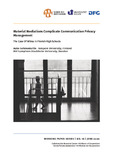Citation link:
http://dx.doi.org/10.25819/ubsi/2651Files in This Item:
| File | Description | Size | Format | |
|---|---|---|---|---|
| WPS_16_Lehmuskallio_Lampinen.pdf | 861.06 kB | Adobe PDF |  View/Open |
| Dokument Type: | Book | metadata.dc.title: | Material mediations complicate communication privacy management | Title addition: | the case of Wilma in Finnish high schools | Authors: | Lehmuskallio, Asko Lampinen, Airi |
Institute: | DFG-Sonderforschungsbereich 1187 "Medien der Kooperation" | Free keywords: | Kommunikationsmanagement, Wilma <software>, communication privacy management, social media, boundary regulation, education | Dewey Decimal Classification: | 302.23 Medien (Kommunikationsmittel), Medienwissenschaft | GHBS-Clases: | KLEA KNZX KNZZ |
Issue Date: | 2020 | Publish Date: | 2020 | Series/Report no.: | Working paper series / SFB 1187 Medien der Kooperation | Source: | SFB 1187 Medien der Kooperation: Working Paper Series, No. 16, 2020. - URL: https://www001.zimt.uni-siegen.de/ojs/index.php/wps1187/issue/view/21. - ISSN: 2567-2517 | Abstract: | Increasingly, school settings are implementing digital technologies to coordinate teachers’ work. The article examines the role of these technologies in teachers’ boundary regulation processes through the lens of communication privacy management theory, and it provides empirical insight into the renegotiation of being a teacher in the presence of rules formalized in software code. The case of Finnish high school teachers exposed to the use of Wilma, a distributed computing system used to store, process, and transmit student data, revealed experiences of a need to renegotiate formalized and trackable work processes, faster and more colloquial communication, and intensified day-to-day work. These influence modes of accountability and the need to negotiate visibility, along with understandings of rules as a central coordination mechanism for interpersonal boundary regulation. The authors suggest in addition that these technologies inure various social stakeholders to constant technical monitoring and regular accounting, thereby advancing the normalization of surveillance practices. This creates good reason to pay closer attention to how rules of engagement may be coordinated. |
DOI: | http://dx.doi.org/10.25819/ubsi/2651 | URN: | urn:nbn:de:hbz:467-16248 | URI: | https://dspace.ub.uni-siegen.de/handle/ubsi/1624 | License: | http://creativecommons.org/licenses/by-nc-nd/4.0/ |
| Appears in Collections: | Publikationen aus der Universität Siegen |
This item is protected by original copyright |
Page view(s)
562
checked on Jan 26, 2025
Download(s)
141
checked on Jan 26, 2025
Google ScholarTM
Check
Altmetric
This item is licensed under a Creative Commons License


